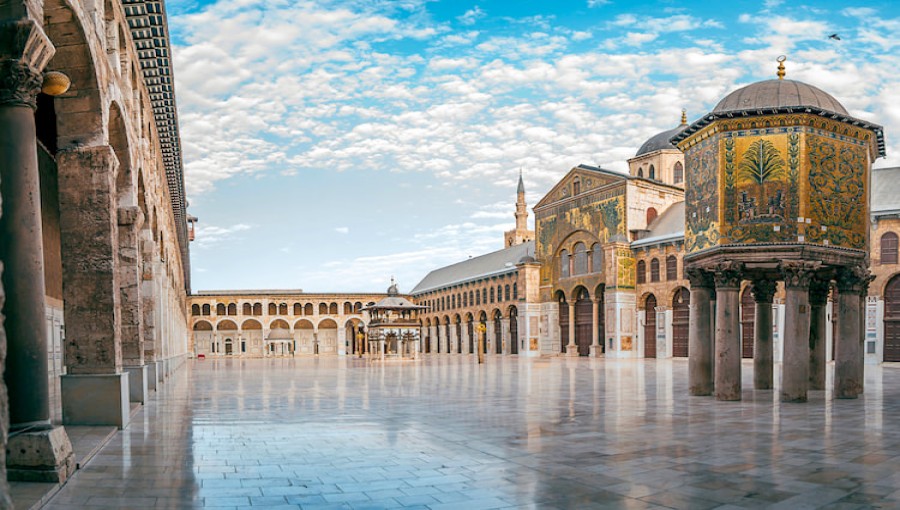The Umayyad Mosque, a symbol of Islamic grandeur and historical significance, lies tucked away within the old city of Damascus, Syria. Known by many names as the Great Mosque of Damascus, this architectural wonder is a symbol of spiritual commitment and cultural legacy in addition to being a place of worship.
Origins and Transformation
The Umayyad Mosque, also known as the Great Mosque of Damascus, emerges from a tapestry of ancient religious heritage. Initially, a site of worship for the Arameans in the Iron Age, it transitioned through Roman rule, hosting a temple to Jupiter, before becoming a Christian church dedicated to St. John the Baptist. With the Muslim conquest of Damascus in 634 CE, part of the church was repurposed as a prayer house for Muslims, later expanded into the grand Umayyad Mosque under the directive of Caliph al-Walid I between 705 and 715 CE.

Architectural Marvels
The mosque's architectural splendor captivates visitors with its vast courtyard adorned by marble columns and intricate mosaics, embodying both Byzantine and Islamic influences. Its central liwan, or hall of worship, features a basilical plan uncommon in contemporary mosques, boasting a concave mihrab. The intricate details within the mosque, including the elaborate mosaics depicting paradisiacal scenes and the geometric interlace on marble grilles, exemplify the craftsmanship of artisans from across empires.
Read: The Jewel of Brunei: Sultan Omar Ali Saifuddin Mosque
Spiritual Significance
Beyond its architectural magnificence, the Umayyad Mosque holds profound spiritual significance for both Christians and Muslims. Tradition venerates it as the burial site of John the Baptist's head, while within its walls, shrines commemorate Husayn ibn Ali, the grandson of the Islamic prophet Muhammad. This dual heritage underscores the mosque's role as a symbol of religious unity and historical continuity.
.png)
Role and Importance
Throughout its storied history, the Umayyad Mosque has served as a focal point for Islamic worship, community life, and intellectual exchange. It has been a center for religious education, with scholars gathering to study and interpret Islamic teachings. Moreover, the mosque has played a pivotal role in shaping the cultural identity of Damascus and serving as a hub for trade, commerce, and social interaction.
Read: A Journey Through Islamic Grandeur
Legacy of the Umayyad Caliphate
The construction of the Umayyad Mosque marked a defining moment in the history of Islam, symbolizing the ascendance of the Umayyad Caliphate and its vision for a unified Islamic state. Under the patronage of Caliph al-Walid I, Damascus emerged as a thriving metropolis and a center of Islamic governance, culture, and learning.
The Umayyad Caliphate's embrace of architectural innovation and cultural exchange left an indelible mark on the Islamic world, influencing subsequent generations of rulers and architects. The Umayyad Mosque stands as a living testament to this legacy, embodying the fusion of diverse artistic traditions and spiritual ideals that define Islamic civilization.
Read: A Look into the Elusive "Imam Husayn Mosque
As we marvel at the architectural splendor of the Umayyad Mosque, let us also reflect on its deeper significance as a symbol of unity, diversity, and resilience. In an era marked by cultural division and conflict, the mosque serves as a reminder of the shared heritage and common humanity that bind us together as members of the global community.
Legacy and Reflection
The Umayyad Mosque’s religious and cultural importance endures. Its survival through centuries of turmoil speaks to its resilience and enduring impact. As we contemplate its history, we are reminded of the interconnectedness of faith, art, and human endeavor. The Umayyad Mosque remains not only a physical structure but also a beacon of spiritual unity and architectural brilliance.































Comment: